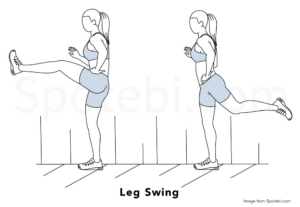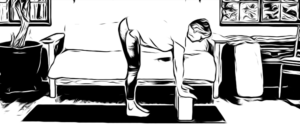
Total hip replacement introduces a new set of considerations for stretching in yoga.
- Your range of motion may be different following your surgery.
- Your surgeon may have given you restrictions on your movement which will limit the kinds of poses you will be able to do. Usually restrictions are lifted after 6-12 weeks.
- You may have lost strength in your core, legs muscles, and in the muscles around your hips. This can effect the stability of the hips.
Because your new hip is different from your old one you will have to learn about the new ways that it can move. This takes time. Start by moving very slowly into your poses and stay aware of how your body is responding. Start your exploration with Mountain Pose/Tadasana, a launchpad for all other standing poses and a perfect place to start for total hip replacement because it establishes principles that support our hips as we move forward in our practice.
If you have restrictions heed them to protect your new hips(s) and focus on strengthening the muscles that stabilize them. Practice standing poses, and chair pose, and review “Feet, Legs, and Pelvis Position in Open-hip Poses.” Standing poses provide the best of both worlds. With a standing pose, you first establish alignment and strength which provides stability for your hips so that when you move more deeply into a pose to find a stretch your hips are supported and safe.
Consider the different categories of stretches and how they might effect THR:
1) Dynamic Stretching – this is when you are moving and stretching at the same time.
– An example of a dynamic stretch of the hamstrings and the hip flexors would be to balance on one leg while swinging the other leg forward and back. This is a good warmup for a pose like Extended Hand to Big Toe Pose/Utthita Hasta Padangusthasana. In addition to stretching, this motion also strengthens these muscles.
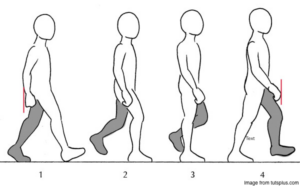
– Another example of dynamic stretching for these muscles is walking. This motion also strengthens and warms up both the hamstrings and the hip flexors. Plus it is a go-to exercise for post-THR recovery.
2) Static-Active Stretching. This is when you use the muscles near the joint to bring a limb or another body part into a stretched position
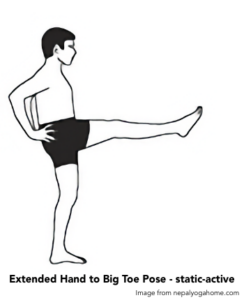
– An example of static-active stretching of the hamstrings in yoga is when you practice Extended Hand to Big Toe Pose/Utthita Hasta Padangusthasana by balancing on one leg and using hip flexor muscles to lift and straighten the other leg in front of you.
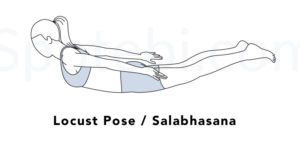
– An example of static-active stretching of the hip flexors is when you practice Locust pose/Salabhasana where you lie on your belly and use your hamstrings to lift your legs to stretch the hip flexors.
3) Static-Passive Stretching – this is when you use gravity, your limbs or some other aid to hold the stretched position.
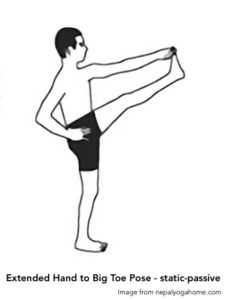
– An example of static-passive stretching of the hamstrings is when you use a strap, your arms, or a chair to support the lifted leg in Extended Hand to Big Toe Pose/Utthita Hasta Padangusthasana.
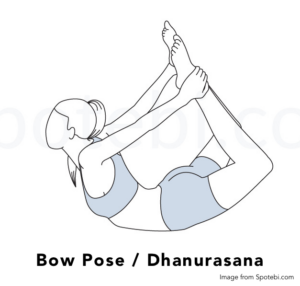
– An example of static-passive stretching of the hip flexors is when you practice Bow Pose/ Dhanurasana
Static-Passive Stretching helps to attain a greater range of movement, but carries with it a slightly higher risk of injury. Anytime you are “pulling” on your body to make it move into a certain shape you are putting extra strain on your joints, tendons, and muscles. If you have had a total hip replacement take care with static-passive stretching especially when your hips are involved.
Follow these rules of thumb when approaching a stretch:
- For the safety of THR use static-active stretching as much a possible while getting to know your new hip(s). You will enjoy the benefits of a stretch while at the same time building muscle strength to stabilize your hips.
- Warm up the muscle(s) you want to stretch with dynamic stretching and with strengthening poses before you stretch. Stretching is safest when a target muscle is warmed-up and when the area you want to mobilize has first been stabilized. By establishing stability with strength you reassure the body that you have created safe circumstances for deeper movement. For this reason make strengthening the main dish while stretching is the delicious go-with.
- It is hard to avoid static-passive stretches in some cases like when practicing Standing Forward Fold/Uttanasana where gravity is involved. Never “fall” into your poses. As gravity pulls you down, use your hamstring muscles, your core muscles, and/or your arm muscles with hands on blocks to control your descent. Move slowly and respect your limits.
Here’s to Healthy and Happy Hips!
Key Takeaways
-
Post-hip replacement, your range of motion and muscle strength may change. Give yourself time to relearn movement and adapt to your new hip.
-
Always follow your surgeon’s movement restrictions, especially during the first 6–12 weeks post-op. These restrictions are essential for safe healing.
-
Begin with foundational poses like Mountain Pose (Tadasana) to establish healthy alignment and stability before moving into deeper stretches.
-
Standing poses and Chair Pose are especially helpful because they combine strength and alignment, which are key for protecting your hips during stretching.
-
Use dynamic and static-active stretching to warm up and strengthen muscles safely. These types of stretching help build stability and support joint health.
-
Be cautious with static-passive stretches that rely on gravity or external aids. While they can improve flexibility, they also carry a higher risk of injury.
-
Stretch with awareness. Never “fall” into poses. Move slowly, stay connected to your body, and prioritize control and alignment over depth.
-
Strengthening is just as important as stretching. Think of strengthening as the main dish and stretching as the side together they support healing and mobility.
Frequently Asked Questions (FAQs)
1. When can I start stretching after a total hip replacement?
Most surgeons advise waiting at least 6–12 weeks before returning to full activity, including yoga. Always follow your doctor’s specific guidelines and move gently when reintroducing stretches.
2. What kind of stretching is safest after hip replacement?
Static-active stretching is often the safest. It involves using your own muscles to move and hold a stretch, which builds strength while increasing flexibility. It’s also more stable for your new joint than passive stretching.
3. What is static-passive stretching, and should I avoid it?
Static-passive stretching uses external force (gravity, straps, or your own limbs) to hold a stretch. While it can help increase flexibility, it should be approached with caution after hip replacement due to the higher risk of strain or injury.
4. What’s a good way to warm up before stretching?
Try dynamic movements like walking or gentle leg swings. These movements help warm up the muscles and prepare them for safe stretching and strength-building poses.
5. Why is strength so important in yoga after hip replacement?
Strong muscles around your hips, core, and legs support the new joint, reduce strain, and help prevent injury. Stability provides a safe foundation for any stretch or movement.
6. Can I still do forward folds like Uttanasana?
Yes, but do them with control. Don’t collapse into the pose. Use your muscles to support the movement, place hands on blocks if needed, and never force a deeper stretch than feels safe.
7. How do I know if I’m stretching safely?
You should feel a gentle stretch, not pain or pinching. If something doesn’t feel right, back off and reassess your alignment. Always move slowly and mindfully.
Non-Members: Preview Yoga Basics
Members view: Mountain Pose/Tadasana, Standing Forward Fold/Uttanasana,
Feet, Legs, and Pelvis Position in Open-hip Poses
Yoga while healing from Total Hip Replacement Surgery: A safe post-op asana practice – Free video
Become a member of Yoga for Hip Replacement here
Articles and Studies:
Stretching and Flexibility: Physiology of Stretching
Go Slow – Build New Neural Pathways

